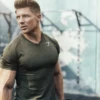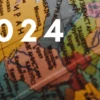Answering brands’ top 5 questions about going circular
Hi, it’s Nicole here from The Renewal Workshop team. We’ve helped major fashion brands to make their businesses more circular by renewing and repairing their used and returned clothing. And now, we’re proud to be part of Bleckmann, helping their clients to do the same.
Many of you will already know about the concept of circularity and why it’s increasingly important in today’s textile industry. We have also covered this topic in one of our recent blogs. Now, let’s discuss another essential question around circularity: what’s the best circular business strategy for your company?
Preparing for fashion circularity
Circularity is shaping up to be as important in the fashion landscape as eCommerce. And it looks like it will require similarly significant adaptations from brands and manufacturers. But as with the shift towards online shopping, early adopters will likely reap the biggest rewards. That’s why it’s important to get prepared now to give yourself the best chance for success as circularity becomes more embedded in the fashion and textiles industry.
So, how can you ensure you’re making the right circularity moves for your business?
At The Renewal Workshop, we've been asked this question a lot. So, we’ve developed a smart framework that considers a variety of factors to help define your brand’s “Circular business personality”. Armed with this information, you can move forward with confidence on your brand’s circular business journey.
What’s your circular business personality?
A “Circular business personality” combines a variety of information about your company – such as brand equity, customer base, and business ambitions – to determine where you can get the most value from circularity. This framework is based on my experience working in the sustainable fashion sector and running The Renewal Workshop’s operations, and it’s been instrumental in helping our clients understand where they fit into the wider circular fashion ecosystem.
Defining your circular business personality is all about finding the “Goldilocks Zone” of change: the steps forward that allow you to progress on your circularity journey at a pace that will benefit both your business and the planet. Read on to find some examples of how brands in the fashion sector have made circularity work for them.
Growing success in a circular future
The Renewal Workshop’s Circularity personalities are based on well-known circular economy principles: the 5 circularity business models. These originated in the CEO guide to the circular economy, published by the World Business Council for Sustainable Development (WBCSD).
This publication outlines five main circular business models: “Circular supplies”, “Product as a service”, “Product life-extension”, “Sharing platform”, and “Resource recovery”. Below, I’ve gathered some examples of how companies in the fashion and textile industries have made them work. See if you can imagine your company working within any of these categories…
Circular supplies
This business model focuses on a company’s upstream impacts: the raw materials and energy you use to run your business. Unless Collective is an innovative streetwear brand that creates fully circular products designed to be compostable. Meanwhile, the lifestyle and fashion company Coyuchi sources its wool from sustainable farms that produce “climate benefit wool” – leading to garments with a net negative CO2 footprint.
Product life extension
Extending a product’s lifespan is another important factor in circular economy business models. Among its many other circularity commitments, outdoor clothing company Patagonia is well known for its repair service, extending the product lifecycle and reducing the need for customers to buy new garments.
Product as a service
Another way to increase the lifespan of products and reduce the amount of clothing sent to landfill is by interrupting a key behaviour in the take-make-dispose pattern: wearing clothes once and throwing them away. Rent the Runway was a pioneer of the clothing rental service model. Can you imagine your brand disrupting linear consumption models in a similar way?
Resource recovery
What if “raw” materials weren’t “raw” at all? That’s the central idea behind the “Resource recovery” business model. Resource recovery often features alongside other circular economy business models. Some good fashion examples include ForDays, whose mission is to “make 100% recyclable fashion in a zero-waste system available to everyone”. Everywhere Apparel also prides itself on sourcing raw materials from 100% recycled sources.
Sharing platform
A relatively new model in the textiles arena is the sharing platform, which allows users to lend clothing peer-to-peer for a fee, from which the company then takes a commission. One recent example is COMN Clothing, a start-up that facilitates clothes-sharing within local communities. This helps to keep clothes out of landfill by creating new demand for used garments.
By understanding the different kinds of circular business models out there, you can start to position your own company within the future circular fashion and textiles economy. And you don’t have to stick to just one model! Some of the most successful companies in the circular textile economy – such as Patagonia – use a smart combination of models (e.g., product life extension and circular supplies). It all depends on your brand personality and your consumer base: what does your audience expect from you, and what are they ready for? Once you’re clear on where you fit into this new circular ecosystem, you’ll have the tools you need to forge ahead on your circularity journey and start making a difference.
Ready to define your circular business personality?
Thanks to our experience working with some of the world’s leading apparel brands to build greater circularity into their business models, The Renewal Workshop has developed a foolproof framework for helping fashion and textile companies discover their circular business personalities. To do this, we’ve combined the WBCSD circular business models with our unique perspective on the fashion and textiles industries to develop three “Circular business personalities” that help your brand understand where you are now and what your next steps should be.
Get to know The Renewal Workshop
Interested in finding out more about how your brand could enter the circular fashion and textiles arena? The Renewal Workshop team offers a free consultation to evaluate your needs, help you understand the volumes and returns you can expect, and set out a roadmap for your circular transition. And the good news is that some of our clients see a profit within months!
During the consultation, we’ll also explore what stage of your circularity journey you’re at currently, and where you can have the biggest impact. For instance, if you’re in charge of sustainable innovation in your business, we can help you set up a pilot to demonstrate the value of circularity to your business leaders. Meanwhile, if you’re running your own company, we’ll help you to navigate your sustainability transition, embedding circularity in your brand’s DNA and helping you share your journey in the most effective way possible.
Taking your next steps
As a decision-maker, you only have time for actions that move your business forward. That’s why it’s essential to prioritise steps that bring the most value out of circular business models. As your dedicated circularity consultants, we’ll help you to understand exactly which circular business model or models correspond best to your needs.
As we discussed in our previous blog, embracing circularity grows brand value, which in turn supports customer retention. And once you establish a clear circularity positioning, you’ll be ready to grow your circularity buy-in with confidence. With circularity increasingly top of mind for consumers, now is the perfect time to make an informed decision and stake your claim in the circular fashion ecosystem.
Ready to learn more? Don’t forget to come back next time to discover the Bleckmann circular business personalities!
Best,
Nicole














